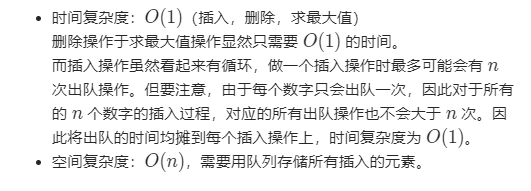【问题描述】[中等]

【解答思路】
1. 暴力
复杂度分析

class MaxQueue {Queue<Integer> queue = new LinkedList();int maxValue;public MaxQueue() {queue = new LinkedList();}public int max_value() {if(queue.isEmpty()) return -1;return maxValue;}public void push_back(int value) {queue.offer(value);if(value > maxValue) maxValue = value;}public int pop_front() {if(queue.isEmpty()) return -1;int ans = queue.poll();if(ans == maxValue){int size = queue.size();if(size == 0){maxValue = Integer.MIN_VALUE;return ans;}maxValue = queue.peek();for(int i = 0; i<size; i++)this.push_back(queue.poll());}return ans;}
}2. 维护一个单调的双端队列

时间复杂度:O(1) 空间复杂度:O(N)

public class MaxQueue {Queue<Integer> queue;LinkedList<Integer> max;public MaxQueue() {queue = new LinkedList<>();max = new LinkedList<>();//LinkedList是双端链表}public int max_value() {return max.size()==0?-1:max.getFirst();}public void push_back(int value) {queue.add(value);while(max.size()!=0&&max.getLast()<value){//注意:这里第二个判断条件不能带等号,即max中对于当前queue中的具有相同值的元素会全部存储,而不是存储最近的那个。max.removeLast();}max.add(value);}public int pop_front() {if(max.size()!=0&&queue.peek().equals(max.getFirst()))//Integer类型的值的比较不能直接使用==max.removeFirst();return queue.size()==0?-1:queue.poll();}/*** Your MaxQueue object will be instantiated and called as such:* MaxQueue obj = new MaxQueue();* int param_1 = obj.max_value();* obj.push_back(value);* int param_3 = obj.pop_front();*/
}【总结】
1.ArrayList与LinkedList对比
ArrayList是顺序结构,所以定位很快,但插入,删除数据慢。
LinkedList 是链表结构,定位慢,但插入,删除数据快。
2.ArrayList与LinkedList常见方法
ArrayList实现了List接口,常见方法有:
add(); contains(); get(); indexOf():定位对象所处的位置; remove(); size(); toArray(); toString();//转换为字符串
LinkedList也实现了List接口外,可以实现上述ArrayList中的常用方法,此外:
1.LinkedList还实现了双向链表结构Deque,可以很方便的在头尾插入删除数据。
LinkedList link = new LinkedList<>();
常用方法:
addFirst(); addLast();
getFirst(); getLast();
removeFirst(); removeLast();
2.LinkedList除了实现了List和Deque外,还实现了Queue接口(队列),
Queue是先进先出队列 FIFO。
Queue< class > queue = new LinkedList<>();
常用方法:
poll()取出第一个元素;
peek()查看第一个元素;
offer()在最后添加元素,可用add()替换;
扩展
先进后出FILO Stack栈:
Stack stack = new Stack<>();
常用方法:
push();可用add();代替
pop();输出末尾的元素相当于LinkedList中的removeLast();
peek();查看最后一个元素,相当于getLast();
3.做题需要不断总结整理归纳
建议和[剑指offer][JAVA]面试题第[09]题[用两个栈实现队列]LinkedList(https://blog.csdn.net/dadongwudi/article/details/106478719)一起学习
参考链接:https://leetcode-cn.com/problems/dui-lie-de-zui-da-zhi-lcof/solution/mian-shi-ti-59-ii-javashi-xian-yuan-li-he-mian-shi/
参考链接:https://leetcode-cn.com/problems/dui-lie-de-zui-da-zhi-lcof/solution/qi-shi-bu-tai-li-jie-jun-tan-fu-za-du-by-acnesu/
参考链接:https://leetcode-cn.com/problems/dui-lie-de-zui-da-zhi-lcof/solution/mian-shi-ti-59-ii-dui-lie-de-zui-da-zhi-by-leetcod/




![[小技巧] ArrayList与LinkedList对比与常见方法](http://pic.xiahunao.cn/[小技巧] ArrayList与LinkedList对比与常见方法)

![[剑指offer]面试题第[60]题[JAVA][n个骰子的点数][动态规划][空间优化]](http://pic.xiahunao.cn/[剑指offer]面试题第[60]题[JAVA][n个骰子的点数][动态规划][空间优化])

![[密码学基础][每个信息安全博士生应该知道的52件事][Bristol Cryptography][第50篇]什么是BLS基于Weil对的签名方案?](http://pic.xiahunao.cn/[密码学基础][每个信息安全博士生应该知道的52件事][Bristol Cryptography][第50篇]什么是BLS基于Weil对的签名方案?)
![[密码学基础][每个信息安全博士生应该知道的52件事][Bristol Cryptography][第51篇]什么是基于ID的加密的安全模型,描述一个IBE方案](http://pic.xiahunao.cn/[密码学基础][每个信息安全博士生应该知道的52件事][Bristol Cryptography][第51篇]什么是基于ID的加密的安全模型,描述一个IBE方案)

![[密码学基础][每个信息安全博士生应该知道的52件事][Bristol Cryptography][第52篇]选择一个先进的应用概念,如电子投票、拍卖或多方计算。这种系统的大致安全要求是什么?](http://pic.xiahunao.cn/[密码学基础][每个信息安全博士生应该知道的52件事][Bristol Cryptography][第52篇]选择一个先进的应用概念,如电子投票、拍卖或多方计算。这种系统的大致安全要求是什么?)

![[Leetcode][第96题][JAVA][不同的二叉搜索树][动态规划][数学]](http://pic.xiahunao.cn/[Leetcode][第96题][JAVA][不同的二叉搜索树][动态规划][数学])

![[剑指offer]面试题第[61]题[JAVA][扑克牌中的点数][HashSet][数组]](http://pic.xiahunao.cn/[剑指offer]面试题第[61]题[JAVA][扑克牌中的点数][HashSet][数组])
![[剑指offer]面试题第[65]题[JAVA][不用加减乘除做加法][位运算]](http://pic.xiahunao.cn/[剑指offer]面试题第[65]题[JAVA][不用加减乘除做加法][位运算])
H.封印之门 最短路)
![[密码学基础][每个信息安全博士生应该知道的52件事][Bristol Cryptography][第4篇] P类复杂问题](http://pic.xiahunao.cn/[密码学基础][每个信息安全博士生应该知道的52件事][Bristol Cryptography][第4篇] P类复杂问题)
